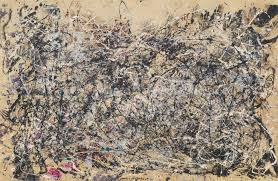Researchers confirm Manganese Blue as Source of Colour in Jackson Pollock's Painting Number 1A
Tuesday, September 16, 2025

Scientists have uncovered the source of the blue hue in one of Jackson Pollock's paintings, using chemistry to confirm that he employed a synthetic pigment called manganese blue.
The artwork, Number 1A, 1948, features Pollock's signature technique of dripping and splattering paint, resulting in a vibrant, multicoloured canvas. Pollock added a personal element by imprinting his handprints near the top of the piece.
The painting is currently exhibited at the Museum of Modern Art in New York and spans nearly 9 feet (2.7 metres) in width. While researchers had previously identified the reds and yellows on the canvas, the origin of the striking turquoise blue remained a mystery. In a recent study, scientists analysed samples of the blue paint using lasers to scatter light and measure molecular vibrations, which provided a unique chemical fingerprint identifying it as manganese blue.
This analysis, published in the journal Proceedings of the National Academy of Sciences, marks the first confirmed use of this specific blue by Pollock. "It's really interesting to understand where some striking colour comes from on a molecular level," said Edward Solomon from Stanford University, who co-authored the study. Manganese blue was once popular among artists and used to colour swimming pool cement but was phased out in the 1990s due to environmental concerns. Gene Hall from Rutgers University, who has studied Pollock's work but wasn't involved in this discovery, noted that previous research hinted at manganese blue being used in the painting. "I'm pretty convinced that it could be manganese blue," Hall stated. The researchers further examined the pigment's chemical structure to understand how it produces such a vivid shade.
Scientists often study art supplies' chemical makeup to preserve old paintings and detect forgeries. Pollock's technique of pouring paint directly onto canvases allows for more precise sampling compared to mixing paints on a palette beforehand. To unravel this artistic enigma, researchers employed various scientific tools similar to how Pollock varied his methods, sometimes dripping paint with a stick or using it straight from the can. Pollock's work might appear chaotic, but he rejected that notion, viewing his process as methodical. Abed Haddad, an assistant conservation scientist at the Museum of Modern Art and co-author of the study, remarked on this similarity: "I actually see a lot of similarities between the way that we worked and the way that Jackson Pollock worked on the painting." Understanding these pigments not only sheds light on Pollock's techniques but also aids in conserving his artworks for future generations. This discovery adds another layer to appreciating Pollock's innovative approach to art.
Main Image: Jackson Pollock Number 1A, 1948 Copyright © 2025 Pollock-Krasner Foundation / Artists Rights Society (ARS), New York
